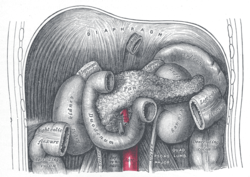Colic flexures
| Colic flexures | |
|---|---|
 The hepatic and splenic flexures labelled at either side of transverse colon | |
 | |
| Details | |
| Precursor | Hindgut |
| Identifiers | |
| Latin | Flexura coli |
| Anatomical terminology | |
There are two colic flexures, or curvatures in the transverse colon. The one on the right, the right colic flexure is also known as the hepatic flexure.[1]
The one on the left, the left colic flexure is also known as the splenic flexure.[1] Note that "right" refers to the patient's anatomical right, which may be depicted on the left of a diagram.
Structure[]
Right colic flexure[]
The right colic flexure or hepatic flexure (as it is next to the liver) is the sharp bend between the ascending colon and the transverse colon. The hepatic flexure lies in the right upper quadrant of the human abdomen. It receives blood supply from the superior mesenteric artery.
Left colic flexure[]
The left colic flexure or splenic flexure (as it is close to the spleen) is the sharp bend between the transverse colon and the descending colon. The splenic flexure receives dual blood supply from the terminal branches of the superior mesenteric artery and the inferior mesenteric artery.[2]
Clinical significance[]
The splenic flexure is the last and highest positioned flexure in the colon. Gas can build up at this flexure and give abdominal pain giving rise to a condition known as splenic flexure syndrome. Splenic flexure syndrome is often found in those with irritable bowel syndrome (IBS), and is considered by some practitioners to be a type of IBS since it can also result from stress.[3]
The splenic flexure is a watershed region as it receives dual blood supply from the terminal branches of the superior mesenteric artery and the inferior mesenteric artery, thus making it prone to ischemic damage in cases of low blood pressure because it does not have its own primary source of blood. In the context of bowel ischemia in particular ischemic colitis, the splenic flexure is sometimes referred to as Griffith's point, along with the upper rectum (Sudeck's point).[4][2]
Additional images[]

Intestines

Double contrast barium enema - Using positive and negative contrast
References[]
- ^ a b Jones, Jeremy. "Transverse colon | Radiology Reference Article | Radiopaedia.org". Radiopaedia. Retrieved 2 January 2022.
- ^ a b Dixon, Andrew. "Griffiths point | Radiology Reference Article | Radiopaedia.org". Radiopaedia. Retrieved 2 January 2022.
- ^ "What Is the Splenic Flexure?". WebMD. Retrieved 2 January 2022.
- ^ Amini, Afshin; Nagalli, Shivaraj (2021). "Bowel Ischemia". StatPearls. StatPearls Publishing. Retrieved 2 January 2022.
External links[]
- Lotti M. Anatomy in relation to left colectomy
- Anatomy photo:37:13-0102 at the SUNY Downstate Medical Center
- Anatomy image:8182 at the SUNY Downstate Medical Center
- Large intestine

